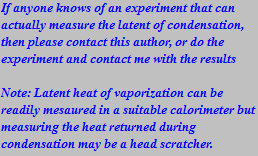Emphasizing Parameter Perspective for Work
Consider a heated expanding system, i.e. heated expanding closed piston-cylinder. Next consider dQin as the heat in that drives expansion, dEsys as the change to the expanding system's energy and (PdV)atm as the lost work (AKA irreversible work) the following first law based relation holds:
dQin = dEsys +(PdV)atm = dEsys + PatmdVsys (A)
Equation (A) is correct while it would be incorrect to write the following:
dQin = dEsys + (NkT)In(Vf/Vi) (B)
The only way that eqn (B) could be contemplated as being correct is if dEsys represented all the system's energy change except that associated with the mechanical parameters change i.e. pressure and/or volume change! Even then it would still be lacking when defining any work that was done! If one wanted to include the work done onto equation (B) then you would have to write the following:
dQin = dEsys + [(NkT)In(Vf/Vi)]sys + PatmdVsys (C)
Of course if the internal energy change (dEsys) remains the change to the expanding system's energy i.e. change as the summation of all its microscopic energies changes, then the only correct way to write the equation remains (A)!!! In other words writing work in terms of the expanding (or compressed) gas's parameters is not writing the work in terms that can be applied to the first law!!!
Illusionary Reversible Work
It should be stated that too often W= [(NkT)In(Vf/Vi)]sys is traditionally mistakenly considered as being reversible work.
See Illusionary Reversible work
Another Perspective
As stated in the internal energy blog: In thermodynamics the internal energy (E) is often taken to be either:
1) the kinetic energy plus potential energy within a system.
2) The summation of the system's microscopic energies
Consider 1): What is the system's kinetic energy? It is the energy associated with the microscopic random disordered
motions of the atoms and/or molecules within a system. This traditional perspective is sometimes referred to as the “invisible microscopic
energy”. See: (click here)
Again it sounds so logical until you realize that the pressure in a given volume of a gaseous
system is defined by the system’s kinematics i.e. the system’s energies associated with its molecular random motions, or if you prefer
its kinetic energy. Based upon kinetic theory; a gaseous system’s pressure is a result of the various molecule’s kinetic
energies (translational plus rotational). This statement remains true whether you consider traditional kinetic theory or ournew improved kinetic theory, which clearly better explains empirical findings.
If the internal energy and pressure in a given volume are both a result of the same gaseous system’s molecular kinetic energies (translational plus rotational), then why would you add E to PV i.e. TS = E +PV or H=E+PV? It is completely illogical because the energy associated with the mechanical parameters pressure and volume of a gas is what is readily witnessed on a macroscopic scale.
One can readily envision that the above 2) summation of the system's microscopic energy is nothing short of a fancy way of saying the system's total energy, which is a simple way of sayings its kinetic plus potential energy. Again this imposes the question of if P and V are a result of these energies then why add PV to E?
Again the only logical equation with clarity remains (A).
-----------------------------
Understanding
work as an inexact differential : Ideal Gas and Work
A mathematical analogy for this work is obtained by defining the process
as isothermal (dT=0), thus the ideal gas law [PV=NkT] tells us that the pressure multiplied by volume equals a constant (C’), i.e.:
PV=NkT=C’ (1)
When the work required varies with the location at which the force is applied, the line integral is often used to calculate the work involved. Now work is the integration of infinitesimal changes. Therefore, the total work (W) is defined by the integration of infinitesimal work (dw), as follows:
W=integral (dw) = integral(Pdv) (3)
Notice that we transformed infinitesimal work (dw) into infinitesimal volume change (dv). Work now takes the more general form that being the summation of all the work associated with each infinitesimal volume change. Substituting eqn 2 into eqn 3, gives:
W=integral (dw) = C’integral (dv/V) (4)
Performing the integration gives:
W=C’In(Vf/Vi) (5)
which can be rewritten for the isothermal work as:
W=(NkT)In(Vf/Vi) (6)
Eqn 6 adheres to the traditional conceptualization for work. However, it possesses the following inherent ambiguity that is not
traditionally acknowledged. That being that it can equally be written in terms of pressure change,
W=(NkT)In(Pi/Pf) (7)
Although it is a moot point , a possible reason that traditional thermodynamics is always written in eqn 6
rather than eqn 7 is the preference of volume over pressure as a parameter of relevance. In my previous blogs I gave a reason
for this oversight that being that volume increases are wrongly attributed to entropy increases, when entropy (S) is considered in
terms of Boltzmanns consideration [S=kIn(@)], where @ is the number of accessible states
Note when I wrote my first edition of my book I have to admit that I was thinking in terms dE represently all the system's energy changes other than those associated with the mechanical parameters. It lead to illogical issues.








